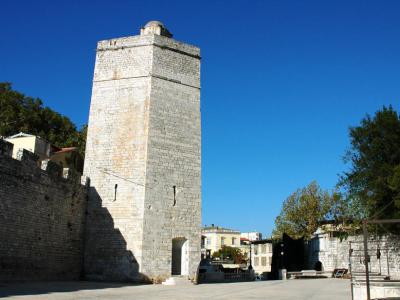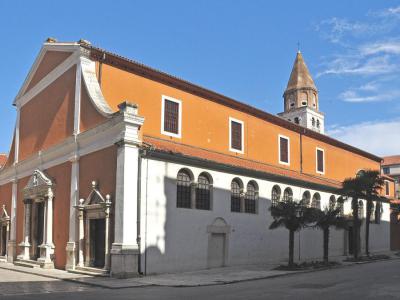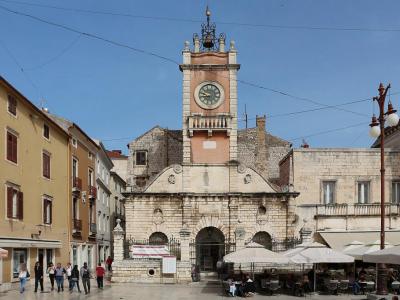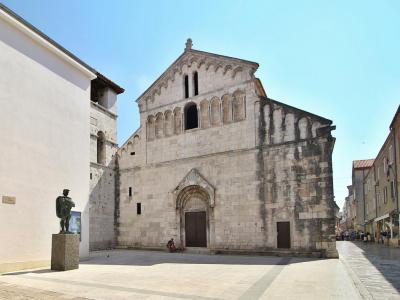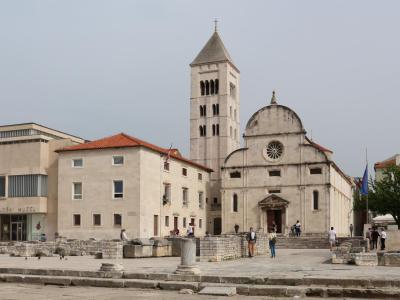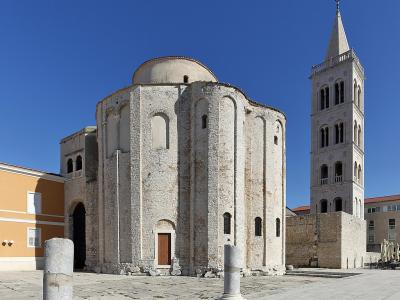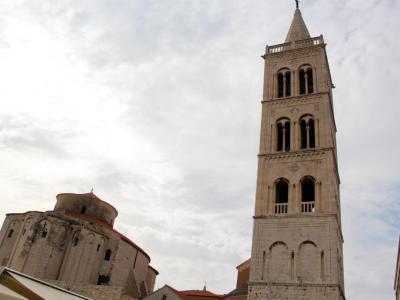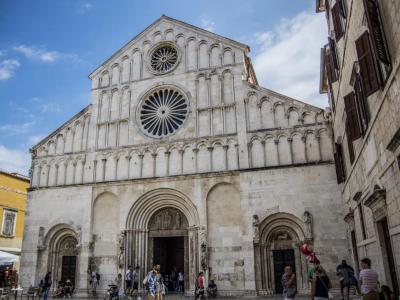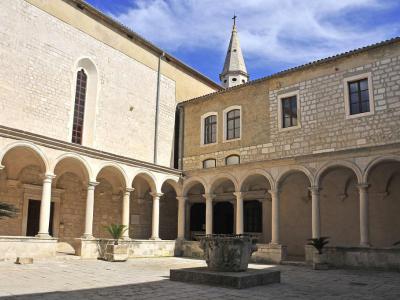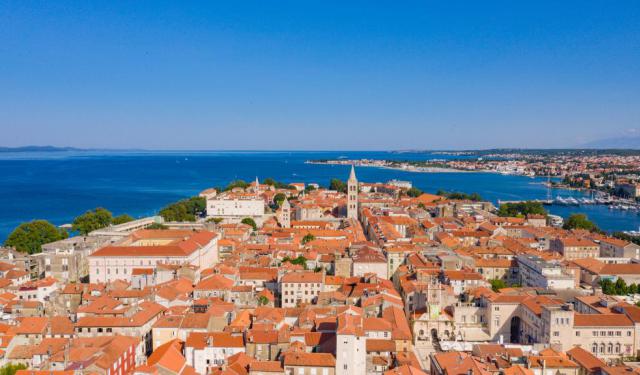Zadar's Architecture Walking Tour (Self Guided), Zadar
Zadar's architecture is a tapestry woven with the threads of Roman, Byzantine, and medieval influences, each contributing to a rich and vibrant heritage. Indeed, as you walk the streets of Zadar, you can't help noticing a plethora of ancient buildings reflecting the varied cultural influences imposed on the city over the centuries.
This part of Croatia’s Dalmatian coast has been inhabited since prehistoric times. The city itself was founded by Romans, and, quite naturally, one of the most significant examples of historical architecture in Zadar is the Roman Forum. The ancient Forum, built in the 3rd century AD, stands as a testament to the enduring legacy of classical architecture, while the monumental round edifice of St. Donatus Church nearby, featuring pre-Romanesque style, offers a glimpse into the artistic achievements of early Christian stone masons.
Zadar's medieval architecture is just as noteworthy, particularly the soaring walls and towering gates surrounding the old town, which today are still largely intact. These fortifications evoke the strength and resilience of the city's medieval inhabitants, complementing the notable sanctuaries of the period, such as the Church of St. Mary and the Cathedral of St. Anastasia, both erected in the 12th century.
Walking through Zadar's old town is like taking a journey through time, with each twist and turn revealing new wonders of architectural beauty and historical significance. Give these buildings a moment of your time and you will hear a symphony of styles and influences, each adding its own unique note to a timeless composition that continues to captivate and inspire visitors to Zabar to this very day.
This part of Croatia’s Dalmatian coast has been inhabited since prehistoric times. The city itself was founded by Romans, and, quite naturally, one of the most significant examples of historical architecture in Zadar is the Roman Forum. The ancient Forum, built in the 3rd century AD, stands as a testament to the enduring legacy of classical architecture, while the monumental round edifice of St. Donatus Church nearby, featuring pre-Romanesque style, offers a glimpse into the artistic achievements of early Christian stone masons.
Zadar's medieval architecture is just as noteworthy, particularly the soaring walls and towering gates surrounding the old town, which today are still largely intact. These fortifications evoke the strength and resilience of the city's medieval inhabitants, complementing the notable sanctuaries of the period, such as the Church of St. Mary and the Cathedral of St. Anastasia, both erected in the 12th century.
Walking through Zadar's old town is like taking a journey through time, with each twist and turn revealing new wonders of architectural beauty and historical significance. Give these buildings a moment of your time and you will hear a symphony of styles and influences, each adding its own unique note to a timeless composition that continues to captivate and inspire visitors to Zabar to this very day.
How it works: Download the app "GPSmyCity: Walks in 1K+ Cities" from Apple App Store or Google Play Store to your mobile phone or tablet. The app turns your mobile device into a personal tour guide and its built-in GPS navigation functions guide you from one tour stop to next. The app works offline, so no data plan is needed when traveling abroad.
Zadar's Architecture Walking Tour Map
Guide Name: Zadar's Architecture Walking Tour
Guide Location: Croatia » Zadar (See other walking tours in Zadar)
Guide Type: Self-guided Walking Tour (Sightseeing)
# of Attractions: 9
Tour Duration: 1 Hour(s)
Travel Distance: 1.2 Km or 0.7 Miles
Author: DanaOffice
Sight(s) Featured in This Guide:
Guide Location: Croatia » Zadar (See other walking tours in Zadar)
Guide Type: Self-guided Walking Tour (Sightseeing)
# of Attractions: 9
Tour Duration: 1 Hour(s)
Travel Distance: 1.2 Km or 0.7 Miles
Author: DanaOffice
Sight(s) Featured in This Guide:
- Captain's Tower
- St. Simon's Church
- City Sentinel
- Church of St. Chrysogonus
- St. Mary's Church and Permanent Exhibition of Religion Art
- Church of St. Donatus
- Bell Tower
- Zadar Cathedral
- Monastery of St. Francis of Assisi
1) Captain's Tower
Captain's Tower is a historical landmark located in the coastal city of Zadar. The tower, which stands tall at the entrance of the city's harbor, was built in the 16th century by the Venetians as a part of the city's defensive system against Turkish attacks. Its pentagonal shape is unique and is attributed to the Venetians' innovative approach to fortification design.
The tower gets its name from the nearby residence of the Venetian city captain, who oversaw the defense of the city. From this vantage point, the captain could monitor the harbor and respond quickly to any threats. The tower played a vital role in the city's history, as it helped to repel attacks from the Ottoman Empire and other potential invaders.
In modern times, the tower has been repurposed as an exhibition space, showcasing various exhibitions on the history and culture of Zadar. Visitors can explore the tower's interior, which features several levels of exhibits, and enjoy stunning views of the city and the Adriatic Sea from the tower's top.
Captain's Tower is a significant architectural and historical monument, symbolizing the city's rich past and its enduring resilience. Its strategic location and unique design make it an important attraction for visitors interested in the city's history and culture.
The tower gets its name from the nearby residence of the Venetian city captain, who oversaw the defense of the city. From this vantage point, the captain could monitor the harbor and respond quickly to any threats. The tower played a vital role in the city's history, as it helped to repel attacks from the Ottoman Empire and other potential invaders.
In modern times, the tower has been repurposed as an exhibition space, showcasing various exhibitions on the history and culture of Zadar. Visitors can explore the tower's interior, which features several levels of exhibits, and enjoy stunning views of the city and the Adriatic Sea from the tower's top.
Captain's Tower is a significant architectural and historical monument, symbolizing the city's rich past and its enduring resilience. Its strategic location and unique design make it an important attraction for visitors interested in the city's history and culture.
2) St. Simon's Church
Saint Simon's Church, located in the city of Zadar is a historic site that dates back to the 5th century. The church has undergone multiple alterations over the years, with the most recent taking place in 1980.
One of the most notable features of Saint Simon's Church is the mummified body of Saint Simeon, who is considered to be one of Zadar's patron saints. This 17th-century church is known for being the home of the saint's body, which is a significant draw for tourists and religious pilgrims alike.
The Chest of Saint Simeon is another remarkable feature of Saint Simon's Church. The chest is a rectangular cedarwood sarcophagus in the shape of a chasse, overlaid with silver and silver-gilt plaques. It is said to hold the relics of Saint Simon the God-receiver and is located over the main altar in the church.
The chest is considered to be a masterpiece of medieval art and a unique monument of the goldsmith's craft of the age. It is also one of the most interesting works in gold in Europe and is under the protection of UNESCO. The chest was made by local goldsmiths to an Italian design between 1377 and 1380, making it a valuable historical artifact.
One of the most notable features of Saint Simon's Church is the mummified body of Saint Simeon, who is considered to be one of Zadar's patron saints. This 17th-century church is known for being the home of the saint's body, which is a significant draw for tourists and religious pilgrims alike.
The Chest of Saint Simeon is another remarkable feature of Saint Simon's Church. The chest is a rectangular cedarwood sarcophagus in the shape of a chasse, overlaid with silver and silver-gilt plaques. It is said to hold the relics of Saint Simon the God-receiver and is located over the main altar in the church.
The chest is considered to be a masterpiece of medieval art and a unique monument of the goldsmith's craft of the age. It is also one of the most interesting works in gold in Europe and is under the protection of UNESCO. The chest was made by local goldsmiths to an Italian design between 1377 and 1380, making it a valuable historical artifact.
3) City Sentinel
The City Sentinel in Zadar is a stunning architectural gem designed by a Venetian architect during the late Renaissance era. Its design features a large central clock tower, which makes it an unmistakable landmark in the city. Over time, the building has undergone several renovations, including the addition of a surrounding stone barrier and railing with holes for cannons.
The City Sentinel was once home to the Ethnographic Section of the National Museum, which was one of the most significant collections in the country. Visitors who appreciate the vibrant culture and history of the region will find it worth visiting to explore the rich colours of local national costumes, textiles (weaving and lace), jewellery, agricultural, fishing and household objects.
The collection housed within the City Sentinel offers a glimpse into the rich cultural heritage of the region, providing visitors with a unique opportunity to immerse themselves in the local history and traditions. From colourful costumes to intricate jewellery and everyday objects, the collection is a testament to the skill and craftsmanship of the region's artisans.
The City Sentinel was once home to the Ethnographic Section of the National Museum, which was one of the most significant collections in the country. Visitors who appreciate the vibrant culture and history of the region will find it worth visiting to explore the rich colours of local national costumes, textiles (weaving and lace), jewellery, agricultural, fishing and household objects.
The collection housed within the City Sentinel offers a glimpse into the rich cultural heritage of the region, providing visitors with a unique opportunity to immerse themselves in the local history and traditions. From colourful costumes to intricate jewellery and everyday objects, the collection is a testament to the skill and craftsmanship of the region's artisans.
4) Church of St. Chrysogonus
The Church of Saint Chrysogonus in Zadar is a significant architectural heritage site dating back to the 12th century. This Romanesque church is dedicated to Saint Chrysogonus, the patron saint of the city, and is the only surviving part of a large medieval Benedictine abbey.
Built at the site of a Roman emporium, the Church of Saint Chrysogonus replaced the Church of Saint Anthony the Hermit. The church was consecrated by Lampridius, Archbishop of Zadar, in 1175.
The church is adorned with archaic designs and statues of patron saints Chrysogonus, Anastasia, Simeon, and Zoilus. The frescoes, high altar, and exterior stonework of the church are notable features. The exterior walls of the three apses at the back of the church have several graceful blind arches.
The construction of a bell tower began in 1485 but was abandoned in 1546 and never completed. The church's facade is plain, but the sides are adorned with elaborate columns that resemble Twizzler sticks.
In 1387, Elizabeth of Bosnia, the murdered queen dowager of Hungary and Dalmatia, was secretly buried in the church, where her body remained for three years until being moved to the Basilica of the Assumption of the Blessed Virgin Mary (Székesfehérvár Basilica).
While the Church of Saint Chrysogonus is no longer active, a few evening concerts are held there in July and August. Visitors are advised to call ahead for timings, as the church is rarely open. The Church of Saint Chrysogonus is a beautiful and significant part of Croatia's rich cultural and religious heritage.
Built at the site of a Roman emporium, the Church of Saint Chrysogonus replaced the Church of Saint Anthony the Hermit. The church was consecrated by Lampridius, Archbishop of Zadar, in 1175.
The church is adorned with archaic designs and statues of patron saints Chrysogonus, Anastasia, Simeon, and Zoilus. The frescoes, high altar, and exterior stonework of the church are notable features. The exterior walls of the three apses at the back of the church have several graceful blind arches.
The construction of a bell tower began in 1485 but was abandoned in 1546 and never completed. The church's facade is plain, but the sides are adorned with elaborate columns that resemble Twizzler sticks.
In 1387, Elizabeth of Bosnia, the murdered queen dowager of Hungary and Dalmatia, was secretly buried in the church, where her body remained for three years until being moved to the Basilica of the Assumption of the Blessed Virgin Mary (Székesfehérvár Basilica).
While the Church of Saint Chrysogonus is no longer active, a few evening concerts are held there in July and August. Visitors are advised to call ahead for timings, as the church is rarely open. The Church of Saint Chrysogonus is a beautiful and significant part of Croatia's rich cultural and religious heritage.
5) St. Mary's Church and Permanent Exhibition of Religion Art
Located in Zadar, the Church of Saint Mary is a Benedictine monastery that was established in 1066 on the eastern side of the town's old Roman forum. The noblewoman Čika founded the monastery alongside an existing church and later endowed it with valuable items such as two Hymnariums (collection of hymns) and a prayer book. While the Hymnariums are lost, the prayer book is currently kept in the Bodleian Library in Oxford.
Čika's daughter, Vekenega, became the first successor of Čika and sought financial aid from King Coloman of Hungary to complete the monastery and erect new objects. As a result, the monumental tower bears Coloman's name and was constructed in 1105. The church houses Vekenega's tomb, which is adorned with Latin verses.
The monastery underwent several renovations throughout the centuries, including a Renaissance-style portal and southern facade by Nikola Španić in 1507, and the addition of Baroque motifs to the interior decorations in 1744. During World War II, the church and its surroundings were destroyed by Allied bombing but were rebuilt after the war.
Today, the Benedictine nuns in Zadar own one of the most valuable church collections in Croatia, containing approximately 200 items such as stone sculptures, paintings, wood carvings, and goldsmith's works. Visitors to the monastery can view these exhibits, which have been collected over the centuries, including ancient Bibles, Christian symbols, and old monastery furniture.
Čika's daughter, Vekenega, became the first successor of Čika and sought financial aid from King Coloman of Hungary to complete the monastery and erect new objects. As a result, the monumental tower bears Coloman's name and was constructed in 1105. The church houses Vekenega's tomb, which is adorned with Latin verses.
The monastery underwent several renovations throughout the centuries, including a Renaissance-style portal and southern facade by Nikola Španić in 1507, and the addition of Baroque motifs to the interior decorations in 1744. During World War II, the church and its surroundings were destroyed by Allied bombing but were rebuilt after the war.
Today, the Benedictine nuns in Zadar own one of the most valuable church collections in Croatia, containing approximately 200 items such as stone sculptures, paintings, wood carvings, and goldsmith's works. Visitors to the monastery can view these exhibits, which have been collected over the centuries, including ancient Bibles, Christian symbols, and old monastery furniture.
6) Church of St. Donatus (must see)
The Church of Saint Donatus is not only Zadar’s most famous landmark but also one of its most enduring stories. Its beginnings lie in the 8th and 9th centuries, when Donatus, bishop and diplomat, left his mark on the city. Known as a saint and envoy, he traveled to Constantinople and even to the court of Charlemagne, carrying back relics and influence that tied Dalmatia to the great powers of the time. It was under his direction that the church was built, originally dedicated to the Holy Trinity but later bearing his name, a reminder of the man who shaped both its stones and its legacy.
The site chosen was the very heart of Roman Zadar, the Forum. Blocks from temples and colonnades were repurposed into the church’s foundations and walls, fusing the pagan past with the rising Christian order. Its bold circular design, unlike the basilicas common of the period, gave it a distinctive identity-two concentric galleries wrapped around a central space, its plain stone echoing the austerity of the pre-Romanesque age. The effect was both simple and monumental, a building that looked back to Ravenna and Aachen while remaining firmly rooted in Dalmatian soil.
Survival was not always guaranteed. The church endured sieges, wars, and even the Mongol invasions of the 13th century. Later, the Venetians, French, and Austrians stripped it of its sacred role and turned it into a warehouse. Under Yugoslavia, it became an archaeological museum. Yet each reinvention preserved it, and today its thick walls host concerts and cultural festivals, its acoustics making it a favorite for music that feels timeless in such a space.
Stepping into St. Donatus is stepping into the continuity of Zadar itself-Roman stones, medieval faith, foreign rule, and modern revival all bound within its circular walls. It is less a monument than a living echo, where centuries of resilience and reinvention still resonate.
The site chosen was the very heart of Roman Zadar, the Forum. Blocks from temples and colonnades were repurposed into the church’s foundations and walls, fusing the pagan past with the rising Christian order. Its bold circular design, unlike the basilicas common of the period, gave it a distinctive identity-two concentric galleries wrapped around a central space, its plain stone echoing the austerity of the pre-Romanesque age. The effect was both simple and monumental, a building that looked back to Ravenna and Aachen while remaining firmly rooted in Dalmatian soil.
Survival was not always guaranteed. The church endured sieges, wars, and even the Mongol invasions of the 13th century. Later, the Venetians, French, and Austrians stripped it of its sacred role and turned it into a warehouse. Under Yugoslavia, it became an archaeological museum. Yet each reinvention preserved it, and today its thick walls host concerts and cultural festivals, its acoustics making it a favorite for music that feels timeless in such a space.
Stepping into St. Donatus is stepping into the continuity of Zadar itself-Roman stones, medieval faith, foreign rule, and modern revival all bound within its circular walls. It is less a monument than a living echo, where centuries of resilience and reinvention still resonate.
7) Bell Tower
Zadar's Bell Tower is an impressive and recognizable structure, boasting stunning city views from its elevated location. A part of the Church of St. Anastasia, the tower's Baroque architectural style features numerous stairs leading to its high peak.
The Bell Tower was constructed on two separate occasions. The cathedral's ground floor and first floor were built in 1452, during the tenure of Archbishop Vallares. In contrast, the upper floors were added between 1890 and 1894 by English architect and art historian Thomas Graham Jackson, modeled on the bell tower in Rab.
The tower's three newer upper floors are enclosed on all sides by double biforas, with a flat wall surface adorned with stylized plant mosaic designs. The floors are demarcated by cornices that feature slight mesh decorations. At the top of the Bell Tower, there is a tall eight-sided pyramid culminating in a brass statue of an angel.
Shortly after the completion of the Bell Tower in 1894, damage appeared at the joint of the old and new sections. Architect and conservator Ćiril Iveković determined that the weight of the heavy bells caused the vibration leading to the damage. Consequently, in 1900, Iveković replaced the iron brackets with wooden ones.
The Bell Tower was constructed on two separate occasions. The cathedral's ground floor and first floor were built in 1452, during the tenure of Archbishop Vallares. In contrast, the upper floors were added between 1890 and 1894 by English architect and art historian Thomas Graham Jackson, modeled on the bell tower in Rab.
The tower's three newer upper floors are enclosed on all sides by double biforas, with a flat wall surface adorned with stylized plant mosaic designs. The floors are demarcated by cornices that feature slight mesh decorations. At the top of the Bell Tower, there is a tall eight-sided pyramid culminating in a brass statue of an angel.
Shortly after the completion of the Bell Tower in 1894, damage appeared at the joint of the old and new sections. Architect and conservator Ćiril Iveković determined that the weight of the heavy bells caused the vibration leading to the damage. Consequently, in 1900, Iveković replaced the iron brackets with wooden ones.
8) Zadar Cathedral (must see)
Zadar Cathedral, dedicated to Saint Anastasia, carries with it more than eight centuries of layered history and devotion. Long before the present Romanesque church rose in the 12th and 13th centuries, the site held an early Christian basilica, built in the 5th century and originally dedicated to Saint Peter. Its transformation into the cathedral we know today was guided by both local faith and the influence of powerful neighbors across the Adriatic, but its heart is bound to the story of Saint Anastasia. In the 9th century, Bishop Donatus received her relics from Emperor Nikephoros I, and they were placed in a marble sarcophagus that still rests inside the church, giving Zadar a spiritual connection that extended far beyond Dalmatia.
Over time, the cathedral became both symbol and stage for the city’s triumphs and trials. In 1202, the Fourth Crusade struck Zadar, leaving the church heavily damaged and in need of rebuilding. Under Venetian rule it regained its prominence, its bell tower rising above the old town as both a marker of faith and a reminder of foreign oversight. Even in the modern era the cathedral bore scars of war-bombing raids during World War II damaged parts of the structure, though once again it was restored, just as the city itself endured.
Walking through today, visitors encounter more than relics of faith. The sarcophagus of Saint Anastasia still anchors the apse, while mosaics, carved stone, and later altars speak to centuries of adaptation. The bell tower, completed in the 19th century, now offers sweeping views over rooftops, harbor, and sea, extending the cathedral’s role as a lookout from history into the present. To stand inside this building is to feel Zadar’s resilience, a city whose cathedral continues to gather its people through faith, memory, and the passage of time.
Over time, the cathedral became both symbol and stage for the city’s triumphs and trials. In 1202, the Fourth Crusade struck Zadar, leaving the church heavily damaged and in need of rebuilding. Under Venetian rule it regained its prominence, its bell tower rising above the old town as both a marker of faith and a reminder of foreign oversight. Even in the modern era the cathedral bore scars of war-bombing raids during World War II damaged parts of the structure, though once again it was restored, just as the city itself endured.
Walking through today, visitors encounter more than relics of faith. The sarcophagus of Saint Anastasia still anchors the apse, while mosaics, carved stone, and later altars speak to centuries of adaptation. The bell tower, completed in the 19th century, now offers sweeping views over rooftops, harbor, and sea, extending the cathedral’s role as a lookout from history into the present. To stand inside this building is to feel Zadar’s resilience, a city whose cathedral continues to gather its people through faith, memory, and the passage of time.
9) Monastery of St. Francis of Assisi
The Roman Catholic Franciscan Monastery of Saint Francis Assisi in Zadar, under the jurisdiction of the Franciscan Province of Saint Jerome, dates back to the 13th century. Built in 1221, the monastery and its namesake church were consecrated on October 12, 1282, by bishop Lovro Periandar.
Over the centuries, this religious site has played a prominent role in Zadar's spiritual life and served as the site of the Franciscan school, a forerunner to the present-day University of Zadar. The monastery housed a noteworthy collection of codices, parchments, and a picture gallery. It was here that Saint Jakov Varingez (Giacomo of Bitetto) received his first ordination.
Located in the western part of the city, the monastery's Gothic church is the oldest of its kind in Dalmatia. The main altar, erected in 1672, is situated behind the chapel, which is adorned with intricately carved Gothic choir seats dating back to 1394 by Giacomo da Borgo Sansepolcro.
Adjacent to the choir area is the sacristy, which is of historical significance in Croatia as it was the site of the signing of the Treaty of Zadar in 1358. This treaty marked the end of Venetian control over Dalmatia, as the Venetian Republic relinquished its territorial claims to the Hungarian-Croatian King Louis I.
Over the centuries, this religious site has played a prominent role in Zadar's spiritual life and served as the site of the Franciscan school, a forerunner to the present-day University of Zadar. The monastery housed a noteworthy collection of codices, parchments, and a picture gallery. It was here that Saint Jakov Varingez (Giacomo of Bitetto) received his first ordination.
Located in the western part of the city, the monastery's Gothic church is the oldest of its kind in Dalmatia. The main altar, erected in 1672, is situated behind the chapel, which is adorned with intricately carved Gothic choir seats dating back to 1394 by Giacomo da Borgo Sansepolcro.
Adjacent to the choir area is the sacristy, which is of historical significance in Croatia as it was the site of the signing of the Treaty of Zadar in 1358. This treaty marked the end of Venetian control over Dalmatia, as the Venetian Republic relinquished its territorial claims to the Hungarian-Croatian King Louis I.
Walking Tours in Zadar, Croatia
Create Your Own Walk in Zadar
Creating your own self-guided walk in Zadar is easy and fun. Choose the city attractions that you want to see and a walk route map will be created just for you. You can even set your hotel as the start point of the walk.
Zadar Introduction Walking Tour
Famous Hollywood film director Alfred Hitchcock was captivated by Zadar’s stunning coastline. He even ranked its sunset above that of Key West, Florida.
Zadar rises from a rocky promontory that once stood apart from the mainland, and its earliest name, Jadera, is linked to the Illyrian tribes who settled along the Adriatic coast as early as the 9th century BC. Rome arrived in 59 BC, with... view more
Tour Duration: 1 Hour(s)
Travel Distance: 1.6 Km or 1 Miles
Zadar rises from a rocky promontory that once stood apart from the mainland, and its earliest name, Jadera, is linked to the Illyrian tribes who settled along the Adriatic coast as early as the 9th century BC. Rome arrived in 59 BC, with... view more
Tour Duration: 1 Hour(s)
Travel Distance: 1.6 Km or 1 Miles
The Most Popular Cities
/ view all



